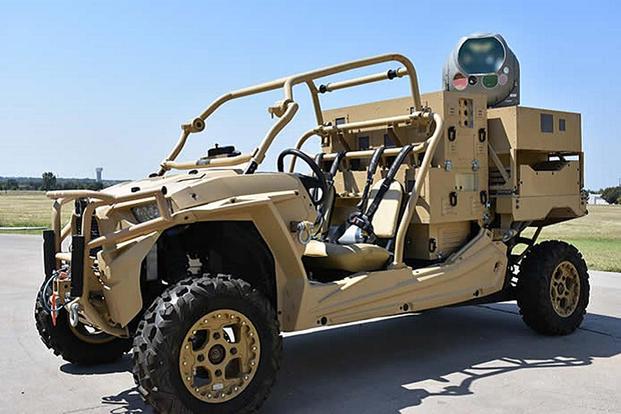It may look like R2-D2 from Star Wars slapped on top of a dune buggy, but Raytheon says its new laser weapon holds the promise of providing maneuver formations with portable air defenses against drones.
"This can identify a quadcopter out to five clicks," or 5,000 meters, and then fry it with a laser, said Evan Hunt, business development lead for high-energy lasers at Raytheon.
Hunt spoke as he stood in the Pentagon's courtyard Monday in front of a Mad Max-style Polaris off-road vehicle mounted with a Raytheon Multi-Spectral Targeting System, a combination of electro-optical and infrared sensors with a high-energy laser (HEL).
The system can operate remotely or as part of an integrated air defense network, he said.
"You can park it at the end of a runway or at a [forward operating base]," Hunt said.
But one of its main advantages, he said, is that the laser can be carried by an off-road vehicle with maneuver formations to provide defense against unmanned aerial systems, or drones.
"Basically, we're putting a laser on a dune buggy to knock drones out of the sky," Dr. Ben Allison, director of Raytheon's high-energy laser product line, said in a company release.
The company says the concept grew out of a meeting between Allison and Raytheon Chairman and CEO Tom Kennedy on adversaries' increased use of small drones for surveillance and as weapons when fitted with small explosives.
In the siege of Mosul last year, the Islamic State of Iraq and Syria (ISIS) used small drones extensively to target the Iraqi Security Forces (ISF).
Kennedy told Allison he had heard that a Patriot missile had been used to shoot down a cheap drone fitted with a grenade-type munition, and they both began thinking there had to be a better cost-to-kill ratio, Raytheon said.
The quadcopters used by ISIS are worth a few hundred dollars, while Patriot missiles cost about $2 million apiece.
"So, the question became, 'What can we do for a counter-UAS system using a high-energy laser, and do it quickly.' We wanted to take the assets and capabilities Raytheon has today and use them to really affect this asymmetrical threat. We settled on a small system that's hugely capable," Allison said.
Art Morrish, vice president of Advanced Concepts and Technology at Raytheon Space and Airborne Systems, said of the system, "Right now, it's a shoot-on-the-halt capability. You drive the vehicle wherever you're going to drive it. You stop, and then you fire up the laser.
"That makes it great for protecting forward operating bases and places where convoys have to stop. The next step is to set it up so you can actually shoot on the move," he said.
Raytheon is expected to demonstrate the system at the Army's Maneuver Fires Experiment at Fort Sill, Oklahoma, this December.
The Polaris mounted with the laser was part of a number of corporate displays in the Pentagon's courtyard in a sign of the military's growing interest and investment in directed energy weapons to defend against an array of threats.
Last month, at an Association of the U.S. Army forum on missile defense, Air Force Gen. John Hyten, commander of U.S. Strategic Command, said the nation needs directed energy weapons -- lasers, particle beams, microwaves -- to take out enemy ballistic missiles in the launch stage.
"The day you can actually shoot a missile down over somebody's head and have that thing drop back on their heads -- that'll be a good day, because as soon as you drop it back on their heads, that's the last one they're going to launch, especially if there's something nasty on top of it," he said.
"I think directed energy brings that to bear," Hyten said, although such weapons do not yet exist in the U.S. arsenal.
"Directed energy is an interesting challenge," he said, but "I think directed energy has a huge potential on the missile defense side."
At a House Armed Services Committee hearing on the budget Tuesday, Air Force Secretary Heather Wilson said her service has $280 million allocated for directed energy research this year.
One of the military's priorities is to develop countermeasures, including lasers, to cope with the proliferation of small drone attacks against U.S. forces, according to a report last month by a National Academies of Sciences, Engineering, and Medicine committee commissioned by the Army.
"Hobby drones are easy to buy, their performance is improving dramatically, and their cost has dropped significantly," said Albert Sciarretta, president of CNS Technologies and committee chairman.
"Now, with millions of them around the world, they pose a growing threat to the U.S. warfighting forces if used for nefarious intents," he said.
The Defense Department has invested in technologies that can jam drones' radio frequencies and make them inoperable.
However, the academy's report states that a new generation of small drones can increasingly operate without radio frequency command-and-control links by using automated target recognition and tracking, obstacle avoidance, and other capabilities enabled by software.
-- Richard Sisk can be reached at Richard.Sisk@Military.com.










